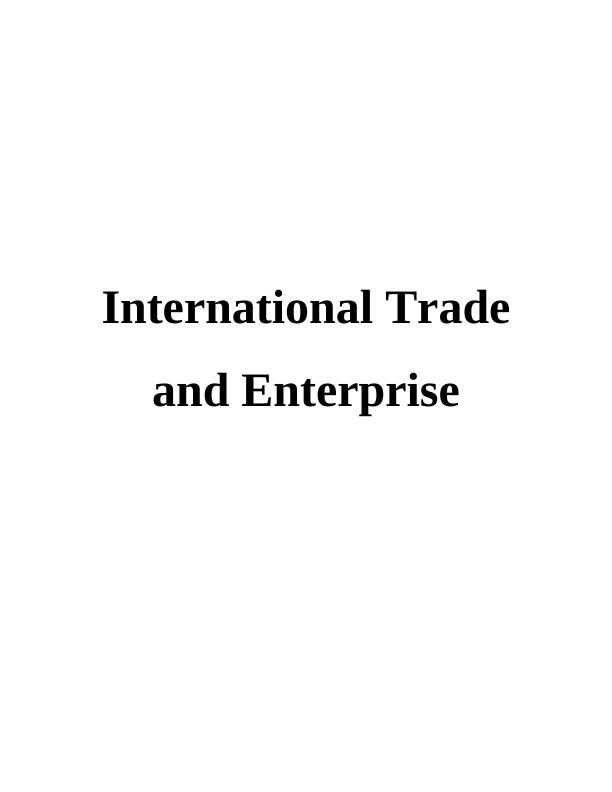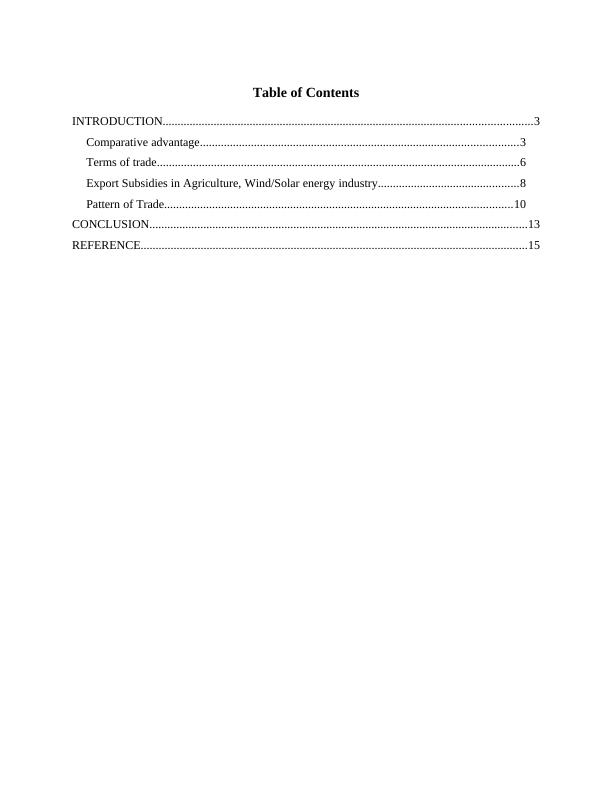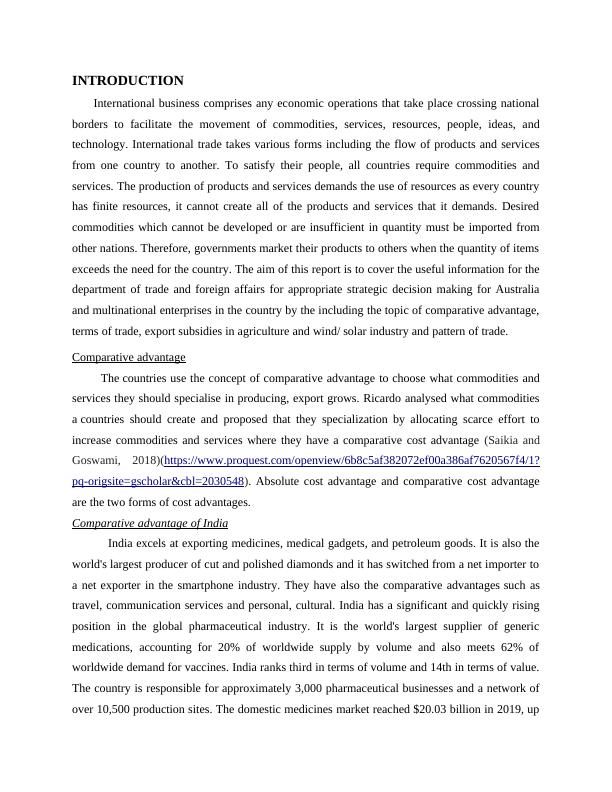International Trade and Enterprise
Added on 2022-11-30
15 Pages4527 Words175 Views
International Trade
and Enterprise
and Enterprise

Table of Contents
INTRODUCTION...........................................................................................................................3
Comparative advantage..........................................................................................................3
Terms of trade.........................................................................................................................6
Export Subsidies in Agriculture, Wind/Solar energy industry...............................................8
Pattern of Trade....................................................................................................................10
CONCLUSION..............................................................................................................................13
REFERENCE.................................................................................................................................15
INTRODUCTION...........................................................................................................................3
Comparative advantage..........................................................................................................3
Terms of trade.........................................................................................................................6
Export Subsidies in Agriculture, Wind/Solar energy industry...............................................8
Pattern of Trade....................................................................................................................10
CONCLUSION..............................................................................................................................13
REFERENCE.................................................................................................................................15

INTRODUCTION
International business comprises any economic operations that take place crossing national
borders to facilitate the movement of commodities, services, resources, people, ideas, and
technology. International trade takes various forms including the flow of products and services
from one country to another. To satisfy their people, all countries require commodities and
services. The production of products and services demands the use of resources as every country
has finite resources, it cannot create all of the products and services that it demands. Desired
commodities which cannot be developed or are insufficient in quantity must be imported from
other nations. Therefore, governments market their products to others when the quantity of items
exceeds the need for the country. The aim of this report is to cover the useful information for the
department of trade and foreign affairs for appropriate strategic decision making for Australia
and multinational enterprises in the country by the including the topic of comparative advantage,
terms of trade, export subsidies in agriculture and wind/ solar industry and pattern of trade.
Comparative advantage
The countries use the concept of comparative advantage to choose what commodities and
services they should specialise in producing, export grows. Ricardo analysed what commodities
a countries should create and proposed that they specialization by allocating scarce effort to
increase commodities and services where they have a comparative cost advantage (Saikia and
Goswami, 2018)(https://www.proquest.com/openview/6b8c5af382072ef00a386af7620567f4/1?
pq-origsite=gscholar&cbl=2030548). Absolute cost advantage and comparative cost advantage
are the two forms of cost advantages.
Comparative advantage of India
India excels at exporting medicines, medical gadgets, and petroleum goods. It is also the
world's largest producer of cut and polished diamonds and it has switched from a net importer to
a net exporter in the smartphone industry. They have also the comparative advantages such as
travel, communication services and personal, cultural. India has a significant and quickly rising
position in the global pharmaceutical industry. It is the world's largest supplier of generic
medications, accounting for 20% of worldwide supply by volume and also meets 62% of
worldwide demand for vaccines. India ranks third in terms of volume and 14th in terms of value.
The country is responsible for approximately 3,000 pharmaceutical businesses and a network of
over 10,500 production sites. The domestic medicines market reached $20.03 billion in 2019, up
International business comprises any economic operations that take place crossing national
borders to facilitate the movement of commodities, services, resources, people, ideas, and
technology. International trade takes various forms including the flow of products and services
from one country to another. To satisfy their people, all countries require commodities and
services. The production of products and services demands the use of resources as every country
has finite resources, it cannot create all of the products and services that it demands. Desired
commodities which cannot be developed or are insufficient in quantity must be imported from
other nations. Therefore, governments market their products to others when the quantity of items
exceeds the need for the country. The aim of this report is to cover the useful information for the
department of trade and foreign affairs for appropriate strategic decision making for Australia
and multinational enterprises in the country by the including the topic of comparative advantage,
terms of trade, export subsidies in agriculture and wind/ solar industry and pattern of trade.
Comparative advantage
The countries use the concept of comparative advantage to choose what commodities and
services they should specialise in producing, export grows. Ricardo analysed what commodities
a countries should create and proposed that they specialization by allocating scarce effort to
increase commodities and services where they have a comparative cost advantage (Saikia and
Goswami, 2018)(https://www.proquest.com/openview/6b8c5af382072ef00a386af7620567f4/1?
pq-origsite=gscholar&cbl=2030548). Absolute cost advantage and comparative cost advantage
are the two forms of cost advantages.
Comparative advantage of India
India excels at exporting medicines, medical gadgets, and petroleum goods. It is also the
world's largest producer of cut and polished diamonds and it has switched from a net importer to
a net exporter in the smartphone industry. They have also the comparative advantages such as
travel, communication services and personal, cultural. India has a significant and quickly rising
position in the global pharmaceutical industry. It is the world's largest supplier of generic
medications, accounting for 20% of worldwide supply by volume and also meets 62% of
worldwide demand for vaccines. India ranks third in terms of volume and 14th in terms of value.
The country is responsible for approximately 3,000 pharmaceutical businesses and a network of
over 10,500 production sites. The domestic medicines market reached $20.03 billion in 2019, up

9.3 percent from 2018. This figure is expected to climb as health insurance and pharmacy
penetration increases. The Indian Pharma Industry's entire market size is estimated to reach $130
billion by 2030 (Indian pharmaceuticals - a formula for success, 2018)
(https://www.investindia.gov.in/sector/pharmaceuticals)
Comparative advantage of China
The Comparative advantage of China is in the field of highly strong industrial centre,
good colleges, a strong commercial, logistical, and service culture and extraordinarily high
penetration and adoption of new technologies.
Reasons or sources of the comparative advantage
India has a comparative advantage of cut and polished diamond as the presence to the
Arabian is the primary factor for the growth of international trade and commerce. Diamond
cutters moved from Africa and settled in Surat, India in the 18th century (Coker and et. al., 2017)
(https://www.cabdirect.org/cabdirect/abstract/20183070816). Some Guajaratis have perfected the
technique of processing, polishing, and cutting. As the need for labourers grew people began to
migrate from other regions of the country to Surat in search of work. The tremendously attractive
industry for diamond jewellery processing is growing by the day. The county's goal is to develop
employees as actual jewellery producers, not only diamond polishers, as part of a development
process.
As a manufacturing powerhouse, China's economy develops, and the country's products appear
to be everywhere and it is because of the supply of inexpensive Chinese labour, which reduces
manufacturing costs. The major portion of Chinese immigrants to industrial areas are rural and
lower-middle-class, and they are ready to work numerous shifts for limited incomes. With its low
manufacturing costs, large labour pool, diverse talent pool, and business ecosystem, China is the
world factory.
Ways to improve the comparative advantage
In India
The Indian government has launched a number of attempts to encourage foreign
investment in India's various industries. It has periodically introduced a variety of enticing plans
and programmes in order to entice investors (Keohane, 2019)
(https://www.taylorfrancis.com/chapters/edit/10.4324/9780429052187-6/theory-hegemonic-
stability-changes-international-economic-regimes-1967%E2%80%931977-robert-keohane).
penetration increases. The Indian Pharma Industry's entire market size is estimated to reach $130
billion by 2030 (Indian pharmaceuticals - a formula for success, 2018)
(https://www.investindia.gov.in/sector/pharmaceuticals)
Comparative advantage of China
The Comparative advantage of China is in the field of highly strong industrial centre,
good colleges, a strong commercial, logistical, and service culture and extraordinarily high
penetration and adoption of new technologies.
Reasons or sources of the comparative advantage
India has a comparative advantage of cut and polished diamond as the presence to the
Arabian is the primary factor for the growth of international trade and commerce. Diamond
cutters moved from Africa and settled in Surat, India in the 18th century (Coker and et. al., 2017)
(https://www.cabdirect.org/cabdirect/abstract/20183070816). Some Guajaratis have perfected the
technique of processing, polishing, and cutting. As the need for labourers grew people began to
migrate from other regions of the country to Surat in search of work. The tremendously attractive
industry for diamond jewellery processing is growing by the day. The county's goal is to develop
employees as actual jewellery producers, not only diamond polishers, as part of a development
process.
As a manufacturing powerhouse, China's economy develops, and the country's products appear
to be everywhere and it is because of the supply of inexpensive Chinese labour, which reduces
manufacturing costs. The major portion of Chinese immigrants to industrial areas are rural and
lower-middle-class, and they are ready to work numerous shifts for limited incomes. With its low
manufacturing costs, large labour pool, diverse talent pool, and business ecosystem, China is the
world factory.
Ways to improve the comparative advantage
In India
The Indian government has launched a number of attempts to encourage foreign
investment in India's various industries. It has periodically introduced a variety of enticing plans
and programmes in order to entice investors (Keohane, 2019)
(https://www.taylorfrancis.com/chapters/edit/10.4324/9780429052187-6/theory-hegemonic-
stability-changes-international-economic-regimes-1967%E2%80%931977-robert-keohane).

End of preview
Want to access all the pages? Upload your documents or become a member.
Related Documents
Impact of Subsidies in Wind Energy on International Tradelg...
|21
|5189
|72
International trade and enterpriseslg...
|15
|4200
|154
India's Comparative Advantage in International Tradelg...
|5
|826
|228
Comparative Advantages in Global Trade: Sources, Benefits, and Exampleslg...
|14
|935
|342
Impact of Climate Change on China and Influence on Agribusiness of Australialg...
|4
|747
|16
International Businesslg...
|9
|2183
|485
